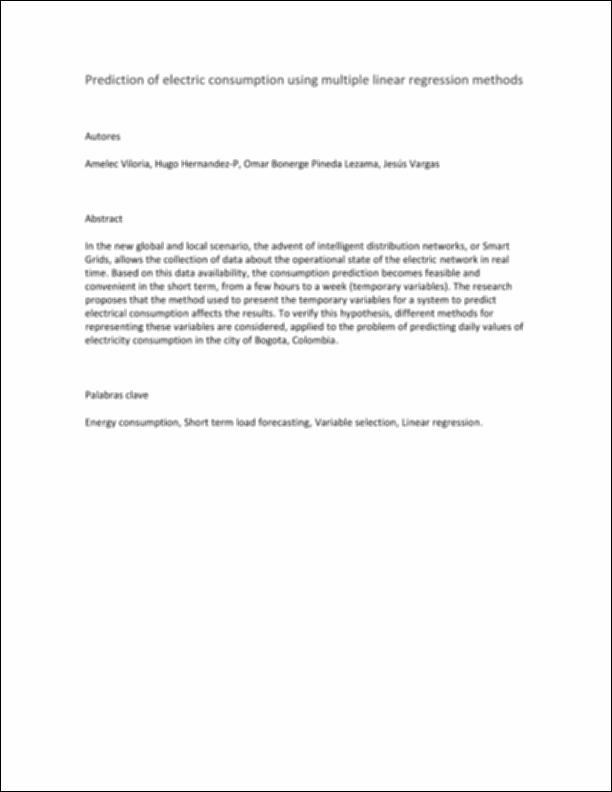Mostrar el registro sencillo del ítem
Prediction of electric consumption using multiple linear regression methods
| dc.contributor.author | Viloria, Amelec | spa |
| dc.contributor.author | Hernandez-P, Hugo | spa |
| dc.contributor.author | Pineda, Omar | spa |
| dc.contributor.author | Vargas, Jesús | spa |
| dc.date.accessioned | 2021-01-28T12:56:37Z | |
| dc.date.available | 2021-01-28T12:56:37Z | |
| dc.date.issued | 2020 | |
| dc.identifier.uri | https://hdl.handle.net/11323/7782 | spa |
| dc.description.abstract | In the new global and local scenario, the advent of intelligent distribution networks, or Smart Grids, allows the collection of data about the operational state of the electric network in real time. Based on this data availability, the consumption prediction becomes feasible and convenient in the short term, from a few hours to a week (temporary variables). The research proposes that the method used to present the temporary variables for a system to predict electrical consumption affects the results. To verify this hypothesis, different methods for representing these variables are considered, applied to the problem of predicting daily values of electricity consumption in the city of Bogota, Colombia. | spa |
| dc.format.mimetype | application/pdf | spa |
| dc.language.iso | eng | |
| dc.publisher | Corporación Universidad de la Costa | spa |
| dc.rights | Attribution-NonCommercial-NoDerivatives 4.0 International | spa |
| dc.rights.uri | http://creativecommons.org/licenses/by-nc-nd/4.0/ | spa |
| dc.source | Lecture Notes in Electrical Engineering | spa |
| dc.subject | Energy consumption | spa |
| dc.subject | Short term load forecasting | spa |
| dc.subject | Variable selection | spa |
| dc.subject | Linear regression | spa |
| dc.title | Prediction of electric consumption using multiple linear regression methods | spa |
| dc.type | Artículo de revista | spa |
| dc.source.url | https://link.springer.com/chapter/10.1007/978-981-15-3125-5_45 | spa |
| dc.rights.accessrights | info:eu-repo/semantics/openAccess | spa |
| dc.identifier.doi | https://doi.org/10.1007/978-981-15-3125-5_45 | spa |
| dc.identifier.instname | Corporación Universidad de la Costa | spa |
| dc.identifier.reponame | REDICUC - Repositorio CUC | spa |
| dc.identifier.repourl | https://repositorio.cuc.edu.co/ | spa |
| dc.relation.references | 1. Perez R et al (2018) Fault diagnosis on electrical distribution systems based on fuzzy logic. In: Tan Y, Shi Y, Tang Q (eds) Advances in swarm intelligence. ICSI 2018. Lecture notes in computer science, vol 10942. Springer, Cham | spa |
| dc.relation.references | 2. Silva V, Jesús A (2013) Indicators systems for evaluating the efficiency of political awareness of rational use of electricity. In: Advanced materials research, vol 601. Trans Tech Publications, Switzerland, pp 618–625 | spa |
| dc.relation.references | 3. Perez R, Inga E, Aguila A, Vásquez C, Lima L, Viloria A, Henry MA (2018) Fault diagnosis on electrical distribution systems based on fuzzy logic. In: International conference on sensing and imaging, June. Springer, Cham, pp 174–185 | spa |
| dc.relation.references | 4. Perez R, Vásquez C, Viloria A (2019) An intelligent strategy for faults location in distribution networks with distributed generation. J Intell Fuzzy Syst 36:1627–1637 (Preprint) | spa |
| dc.relation.references | 5. Xue Y, Lai Y (2016) The integration of great energy thinking and big datas thinking: big data and electricity big data. Power Syst Autom 40(1):1–8 | spa |
| dc.relation.references | 6. Wang Y, Chen Q, Kang C et al (2017) Clustering of electricity consumption behaviour dynamics toward big data applications. IEEE Trans Smart Grid 7(5):2437–2447 | spa |
| dc.relation.references | 7. Liu R, Ding W (2011) Statistical analysis and application of SAS. China Machine Press, China | spa |
| dc.relation.references | 8. Ozger M, Cetinkaya O, Akan OB (2017) Energy harvesting cognitive radio networking for IoT-enabled smart grid. Mob Netw Appl 23(4):956–966 | spa |
| dc.relation.references | 9. Isasi P, Galván I (2004) Redes de Neuronas Artificiales. Un enfoque Práctico. Pearson, London. ISBN: 8420540250 | spa |
| dc.relation.references | 10. Mangasarian O (1997) Arbitrary-norm separating plane. Technical report 97-07, Computer Science Dept., Univ. Wisconsin Madison | spa |
| dc.relation.references | 11. Andersson M (2009) A comparison of nine PLS1 algorithms. J Chemometr 23:518–529 | spa |
| dc.relation.references | 12. Xu Q-S, Liang Y-Z (2001) Monte Carlo cross validation. Chemometr Intell Lab 56:1–11 | spa |
| dc.relation.references | 13. Li H-D, Xu Q-S, Liang Y-Z (2017) A phase diagram for gene selection and disease classification. Chemometr Intell Lab 167:208–213 | spa |
| dc.relation.references | 14. Cao DS, Liang YZ, Xu QS, Li HD, Chen X (2010) A new strategy of outlier detection for QSAR/QSPR. J Comput Chem 31:592–602 | spa |
| dc.relation.references | 15. Tian W (2017) The research into methods of map building and path planning on mobile robots. In: IEEE 2nd information technology, networking, electronic and automation control conference (ITNEC 2017), pp 1087–1090 | spa |
| dc.relation.references | 16. Dugas M et al (2014) Missing semantic annotation in databases. Methods Inf Med 53(6):516–517 | spa |
| dc.relation.references | 17. Silberschatz A, Korth HF, Sudarshan S et al (1997) Database system concepts, vol 4. McGraw-Hill, New York | spa |
| dc.type.coar | http://purl.org/coar/resource_type/c_6501 | spa |
| dc.type.content | Text | spa |
| dc.type.driver | info:eu-repo/semantics/article | spa |
| dc.type.redcol | http://purl.org/redcol/resource_type/ART | spa |
| dc.type.version | info:eu-repo/semantics/acceptedVersion | spa |
| dc.type.coarversion | http://purl.org/coar/version/c_ab4af688f83e57aa | spa |
| dc.rights.coar | http://purl.org/coar/access_right/c_abf2 | spa |
Ficheros en el ítem
Este ítem aparece en la(s) siguiente(s) colección(ones)
-
Artículos científicos [3154]
Artículos de investigación publicados por miembros de la comunidad universitaria.


